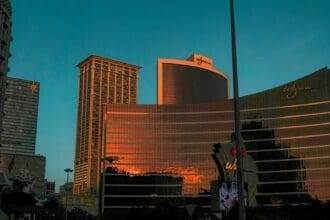A landmark agreement between AD Ports Group and Mira Developments has paved the way for one of the most ambitious urban development projects in the history of the United Arab Emirates. The AED 2.47 billion ($672.5 million) land sale deal kicks off a project with a total investment value of over AED 55 billion ($15 billion). Located in the Al Mamoura district, on a plot within AD Ports Group’s 16-square-kilometre Town Centre Area, a “full-scale small city” will be built, strategically positioned on the economic corridor between Abu Dhabi and Dubai. The impending integration of this corridor with the Etihad Rail network further elevates its strategic value, positioning the new city at the nexus of the UAE’s future multi-modal transport infrastructure.
The project is a clear expression of investor confidence in Abu Dhabi’s long-term economic trajectory and is fully aligned with the goals of the Abu Dhabi Economic Vision 2030—diversifying the economy beyond oil and creating a sustainable, high-quality urban environment that attracts global talent.
Content
Project Deep Dive: The “City within a City” Concept
The vision for the project in Al Mamoura extends far beyond residential construction. Its master plan outlines the creation of a comprehensive, self-sustaining urban environment, meticulously designed to function as a cohesive city in miniature.
Scope and Timeline
The core vision is the creation of a “full-scale small city”—a fully integrated community with its own distinct economic, social, and cultural identity, rather than a peripheral residential suburb. The project will unfold over a strategic 10-year timeframe, with a phased completion schedule culminating in 2035. This long-term horizon allows for a measured rollout of infrastructure and assets, designed to align with projected population growth and market absorption rates. Construction is scheduled to commence within 12 months of the land sale agreement’s effective date, signaling a rapid transition from planning to execution.
Key Components and Infrastructure
The master plan is comprehensive, integrating a vast array of residential, commercial, social, and leisure facilities. The residential mix includes over 16,700 units (14,000 apartments, 1,700 villas, and 1,000 townhouses). This is complemented by a formidable commercial and hospitality hub, including one of the region’s largest shopping malls (nearly 3 million sq. ft.), a business complex, and three hotels (two of which are five-star).
What elevates this development to a self-sufficient city is its deep integration of social infrastructure: two universities, three international schools, eight kindergartens, a 200-bed hospital, and two world-class museums. These facilities are “sticky assets”—they attract and retain a stable, long-term population of families, students, and professionals, thereby creating a resilient community and sustaining long-term property values.
Innovation in Design and Sustainability
Beyond its scale, the project is distinguished by a forward-thinking approach to urban design. A central innovation is the concept of a “Car-Free Upper City.” This design envisions a raised pedestrian level, separated from vehicular traffic, explicitly intended to achieve zero traffic accidents. In a region historically characterized by car-centric design, this is a paradigm shift towards a safer, human-centric model.
This commitment is further reinforced by the project’s ambitious energy goals—to meet up to 60% of its energy needs sustainably through advanced solar technologies integrated into rooftops, façades, and even shaded pedestrian corridors.
The Strategic Partnership: Analyzing the AD Ports-Mira Deal
The genesis of this megaproject is the foundational AED 2.47 billion land sale from AD Ports Group to Mira Developments. This is not merely a real estate deal; it is a strategic partnership that provides critical insights into the financial models underpinning Abu Dhabi’s next wave of urban growth.
AD Ports Group’s Rationale: Asset Monetization and Capital Redeployment
For AD Ports Group, this transaction is a masterclass in strategic asset recycling. The primary financial driver is the monetization of a non-core asset. By selling the land to a specialist developer, AD Ports Group efficiently converts a passive asset into active capital. The proceeds are explicitly earmarked for strengthening the company’s financial position through debt reduction and reinvestment into high-impact growth projects in infrastructure, logistics, and trade facilitation. Furthermore, the structure of the deal as an outright sale transfers the entirety of the long-term development, market, and execution risks to the private developer, while AD Ports Group crystallizes its financial gain upfront.
Mira Developments’ Rationale: A Landmark Entry into the Capital
For Mira Developments, the acquisition of the Al Mamoura land is a transformational move that provides immediate scale and market prominence. The company’s CEO, Timur Mamaikhanov, has described the site as the “best location in whole of UAE.” For a company established as a developer in 2023, spearheading such a monumental project is a massive leap into the top tier of the region’s real estate industry.
Developer Profile: The Rise of Mira Developments
Mira Developments is a relatively new player, but the company has pursued an aggressive and highly specialized strategy. Co-founded in 2023 by Timur Mamaikhanov and Tamara Getigezheva, the firm’s origins lie in the brokerage company MIRA Real Estate. This client-facing experience has shaped its unique business model, which focuses on fully branded, fully furnished, turnkey-ready homes in collaboration with world-renowned luxury brands like Bentley Home, Trussardi, and ELIE SAAB.
Recognizing the immense financial requirements, the project is funded through a combination of the company’s own equity and a partnership with unspecified “Swiss funds.” The reference to Swiss funds is a strategic signal to the market that the project is backed by stable, sophisticated, and credible international capital, mitigating the perceived risk associated with the developer’s relative novelty.
Market Context: The Abu Dhabi Real Estate Renaissance
The project is launching at an exceptionally opportune moment. Abu Dhabi’s economy has recorded 17 consecutive quarters of GDP growth, with the non-oil sectors now contributing over 50% of the total. Government initiatives like the Golden Visa and expanded foreign ownership rights are further fueling the market.
Market data from H1 2025 is compelling:
- Total transaction value reached AED 54 billion (a 42% YoY increase).
- Apartment prices increased by 14% YoY, while villa prices rose by 11%.
- The premium segment accounted for 57% of apartment sales value.
A key element of Abu Dhabi’s appeal is its value proposition relative to Dubai, with average residential prices being approximately 30% lower. The Al Mamoura project is poised to leverage this dynamic by offering a unique luxury product at a more competitive price point.
Strategic Analysis and Future Outlook
This megaproject is a powerful engine for Abu Dhabi’s non-oil economy. The construction phase will create thousands of jobs, and upon completion, the operational “city within a city” will generate sustained employment in hospitality, retail, education, and healthcare.
Opportunities and Potential Challenges
The project has the potential to become a global benchmark for sustainable urban development and act as a magnet for foreign direct investment and talent. However, significant challenges exist:
- Execution Risk: Delivering a project of this complexity on a 10-year timeline is a monumental undertaking.
- Market Cyclicality: The long development horizon means the project will inevitably span multiple economic and property market cycles, requiring resilience and strategic foresight.
- Infrastructure Strain: The new city will place significant demands on surrounding public infrastructure, requiring close coordination with government authorities.
In conclusion, the Al Mamoura project is more than a collection of buildings. It is a transformative act of city-building and a bold bet on the future of Abu Dhabi, with the potential to redefine the urban and economic geography of the UAE.
But does this bold bet make the capital a better investment destination than its neighbor? To see how this project shifts the balance of power, read our comparative report: Dubai vs. Abu Dhabi 2026: Smart Money Analysis.
You might also like:
- The term “blue chip” in real estate: basic concepts and examples
- Where to Invest in 2025: Greece, Spain, or Dubai? | A Comparative Analysis
- Where do Bulgarians most often buy property in Italy: top regions for Bulgarian investors and owners
This post is also available in: Български







